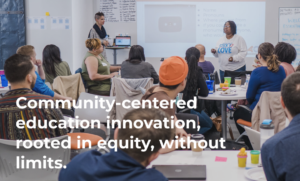The Power of Constraints

I’m about 15 and I’m watching the movie Apollo 13. It recounts the intense effort it took to get three astronauts home after an onboard explosion foils their plan for a third American moon landing. The best part is watching the guys back on Earth trying to figure out how to help the astronauts repair their spacecraft. They realize quickly that they can only use materials the astronauts have available to them. This presents quite a problem. The materials they have on board the spacecraft aren’t necessarily the ones you’d want to use for this particular problem, but what choice do they have? They figure it out, design a fix, the astronauts follow the instructions and, after some intense, hold-your-breath moments, make it back to Earth safely.
In our STEAM class, we’re not asking our students to bring home any astronauts. As far as I know, all the astronauts are safe and sound. What we are having them do is work with some tight constraints, just like the astronauts had to. We’re having them build a vehicle in two hours every Tuesday and then race them each Thursday. Each week the race type changes. Sometimes it’s a speed race. Next time, it could be distance race. The time after that? I don’t know, maybe a launch test to see whose car can get the most air. On top of that, they have to use the materials we give them and nothing else.

At first, we heard whining. “Why can’t we just build whatever we want?” “How am I supposed to make something out of this stuff?” We knew there would be frustration at first, much like there must have been for the NASA team trying to save three astronauts. We also knew that the frustration would eventually subside because their limitations would help activate their creativity.
In a Forbes post David Sturt, an Executive Vice President for O.C Tanner explains, “Constraints give us a starting point and some building blocks to work with—a problem to solve, an innovative twist to be revealed, or a person to please.” Sturt points out that many of the most creative things we encounter started off with some major limitations. The primary colors of red, blue and yellow can be combined in a multitude of ways to give us the vast variety of color we enjoy and “everything on the planet, including each of us, is made up of just 118 known chemical elements.”
In our classrooms, we often think we need to remove restrictions so we don’t cramp our students’ creative style. Apparently, though, the opposite may be true. And if we’re honest with ourselves, we may already know this principle. How often are teachers given major constraints via funding issues, district policies or just time? And yet, we often make magic happen anyway.
Let’s take a closer look at the process. Constraints, whether on our time or the materials we can use, will present us with a problem. Problems can create frustration and stress. According to research done by Dr. Kelly McGongial and Professor Todd Kashdan, stress has the potential to activate the parts of our brain that are linked to critical thinking, problem-solving, and creativity. In essence, without opposition, without constraints, without problems, we don’t have a reason to become creative and to think critically. Chances are, the times in your life when you were able to think of fantastically creative solutions or innovative ideas, were also probably moments when you were facing a tough situation where you had to operate within a tight set of constraints.

Knowing how to apply constraints in the classroom is usually done by trial and error. However, here are some things we’ve learned that may help you:
- Constraints can initially cause frustration and stress. Be prepared with some protocols designed to assist in problem-solving and critical thinking. One simple protocol would be to have your students look at each thing they can use for the assignment and dig deeper into those pieces, breaking them down to unlock their possibilities. This helps students move closer to the problem instead of backing away, as sometimes happens.
- Let them have lots of practice working with constraints in non-assignment related ways to help train their brains for the task. Ever played chess? Each piece has its own constraints and the ability to work with those constraints eventually determines the winner. Working with constraints can be an everyday exercise.
- Lastly, and this is probably the most important tip, only apply constraints in such a way that the situation still allows for multiple solutions. If only one solution works, you’ve effectively killed creativity. Ever tried one of those escape rooms where you have to solve puzzles and riddles to get out of a locked room? There’s usually only one solution. How much more fun would it be if multiple solutions existed?
Here’s the thing with making your students solve problems and create solutions under constraints; it mimics many, if not all, of the situations they’ll encounter later on. The problems of our world come with limitations. We need a reliable, renewable energy source that won’t pollute the planet or poison us. Talk about some constraints there! We need to feed everyone, even those who live in places where farming can’t be done. Work through those limitations and you can save lives. Our students are entering a world and a workforce that desperately need critical thinkers and problem solvers. We need every tool we can get a hold of to help them practice these skills.
So toss your students some curve balls and watch them throwback mind-blowing solutions as they become the great minds of the future.
For more, see:
- At The Intersection of Creativity and Critical Thinking
- Creativity: The Most Common Superpower
- The Case for School Masterspaces, According to Those Who Use Them
- Creating the Right Culture for Social and Emotional Learning
Stay in-the-know with all things EdTech and innovations in learning by signing up to receive the weekly Smart Update.








0 Comments
Leave a Comment
Your email address will not be published. All fields are required.